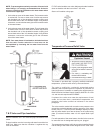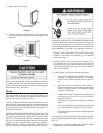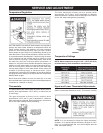
18
The upper and lower thermostats are adjustable if a different
water temperature is desired. Read all warnings in the
“Temperature-Regulation” section before proceeding.
1. Turn “OFF” the electric power to the water heater at the
junction box.
2. Take off the upper and/or lower access panel, insulation
cap with handle.
3. The slotted adjustment (using a screwdriver) can be turned
clockwise (
) to increase the temperature setting or
counter clockwise (
) to decrease the temperature setting.
4. Replace the insulation cap with handle and access panel.
5. Turn “ON” the power supply.
Anode Rod Inspection
The anode rod is used to protect the tank from corrosion. Most
hot water tanks are equipped with an anode rod. The
submerged rod sacrifices itself to protect the tank. Instead of
corroding the tank, water ions attack and eat away the anode
rod. This does not affect the water’s taste or color. The rod
must be maintained to keep the tank in operating condition.
Anode deterioration depends on the water conductivity, not
necessarily water condition. A corroded or pitted anode rod
indicates high water conductivity and should be checked and/
or replaced more often than an anode rod that appears to be
intact. Replacement of a depleted anode rod can extend the
life of your water heater. Inspection should be conducted by
calling Sears Service Center. At a minimum the anode(s)
should be checked annually after the warranty period.
Temperature-Pressure Relief Valve Operation
The temperature-pressure relief valve must be manually
operated at least once a year.
The temperature-pressure relief valve must be manually
operated at least once a year. Caution should be taken to ensure
that (1) no one is in front of or around the outlet of the
temperature-pressure relief valve discharge line, and (2) the
water manually discharged will not cause any property damage
or bodily injury. The water may be extremely hot.
FIGURE 28.
If after manually operating the valve, it fails to completely reset
and continues to release water, immediately close the cold
water inlet to the water heater, follow the draining instructions,
and replace the temperature-pressure relief valve with a new
one.
Failure to install and maintain a new properly listed temperature-
pressure relief valve will release the manufacturer from any
claim which might result from excessive temperature or
pressure.
If the temperature-pressure relief valve on the appliance weeps
or discharges periodically, this may be due to thermal
expansion. Your water heater may have a check valve installed
in the water line or a water meter with a check valve. Consult
your local Sears Service Center for further information. Do not
plug the temperature-pressure relief valve.
Draining


















